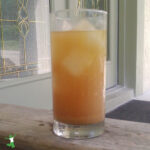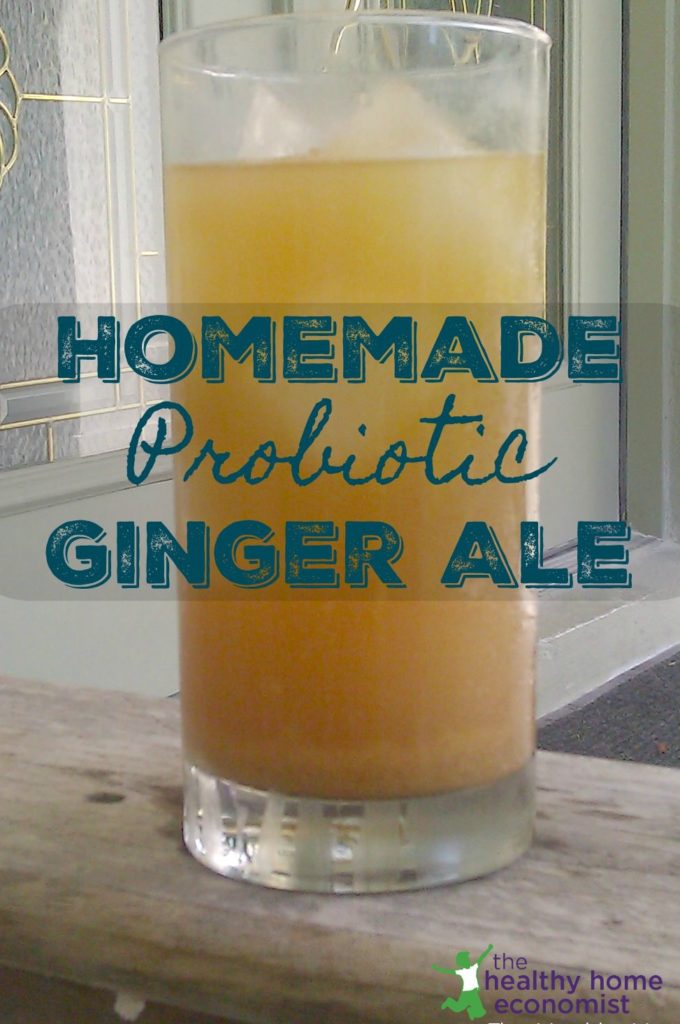Table of Contents[Hide][Show]
A traditional recipe for homemade ginger ale that is lightly fermented with cultured starter, which adds beneficial probiotics and enzymes for digestive benefits as well as delicious taste!

Ginger ale is one of the easiest drinks to whip up at home in a matter of minutes.
The bonus of making ginger ale yourself is that you can ferment it.
This means it is loaded with beneficial bacteria known as probiotics. In addition, traditionally brewed ginger ale is rich in enzymes and has enhanced nutritional value.
Fermentation of grains, fruits and herbs into refreshing and delicious drinks is nearly universal in ethnic cuisines, according to the Nourishing Traditions cookbook, from which this beverage recipe is adapted.
Sadly, the emphasis on convenience in our modern society means that this practice is largely forgotten with the continued popularity of commercial sodas.
Modern versions of ancestral beverages offer no redeeming nutritional benefit.
Worse, the consumption of these sugar-laced or artificially sweetened drinks encourages obesity and other chronic ailments.
Soda really can be healthy! Learning traditional preparation techniques is all that is required.
Preparation Tips
Raw liquid whey is the suggested starter for this beverage and the one I’ve used for decades with great success.
Please refer to this article on the various methods for making raw whey at home for additional details to determine which approach works best for you.
Note that you cannot buy raw whey commercially, although some small dairy farms have it available for purchase.
If a dairy allergy is present, a quarter cup of ginger ale starter or “ginger bug” or water kefir is a simple substitution.
Other ideas for dairy-free fermentation are detailed in the linked article.
While sucanat (pure dried cane juice) is the recommended sweetener, jaggery is a healthy option as well that produces great results.
Raw honey also works for those on gut healing diets such as GAPS. Note that the fermentation will generally occur a bit more quickly using it. I suggest reducing the fermentation time to 1-2 days if using raw honey.
A secondary fermentation using bottles to add additional fizz is optional, but a great idea if you have the time and inclination!

Homemade Ginger Ale Recipe
A traditional recipe for homemade ginger ale that is lightly fermented with cultured starter which adds beneficial probiotics and enzymes to the brew.
Ingredients
- 2 quarts filtered water
- 1/2 cup lime juice freshly squeezed, about 3 limes (preferably organic)
- 2 tsp ground ginger or 2 Tbsp freshly chopped ginger
- 1/3 cup sucanat
- 1 tsp sea salt
- 1/4 cup liquid whey do not use powdered whey
- 1-2 Tbsp raw honey optional
- pinch green stevia powder optional
Instructions
-
Mix all ingredients together thoroughly in a half gallon glass jar. Be sure to leave 1 inch at the top else the soda will get moldy instead of ferment. Affix a secure lid.
-
Leave at room temperature on the counter to culture for 2-3 days and then refrigerate. Homemade ginger ale is mildly fizzy. You can then mix with sparkling mineral water post-fermentation to add even more fizz if desired.
-
Alternatively, you can bottle the homemade soda and leave on the counter for an additional 1-2 days before refrigerating to produce a very fizzy beverage. Be sure to let the bottled soda get very cold before opening. Opening in the sink is a good idea.
-
If the finished homemade ginger ale is not sweet enough for your taste (usually necessary for those coming off a soda habit), add a pinch of optional stevia or stir in a small amount of raw honey.

Other Fermented Beverages to Try!








That is really intriguing! I’m taking the first step today … I’ll be making my own whey for the first time. I am passing this recipe info along to a friend as well, whose wife is undergoing cancer treatment and who finds even the store-bought ginger ale to be helpful for her nausea. I’m sure this homemade ginger ale would be oh, so much better (and better for her).
Looks delicious and ginger is super healthy! Will be trying this soon – thanks 🙂
Next on my to-do list of drink recipes. Looks delicious! http://t.co/7G9Gvup
I am really enjoying raspberry kefir water!
I’m wondering how you would tweak the recipe if you used fresh ginger? have you tried that instead of the ginger powder?
Yes, I’ve tried fresh ginger (use 3/4 cup finely grated and peeled). It just takes so much time to grate the ginger so I typically make with the ginger powder. The results are basically the same taste-wise. I’m sure the version with the fresh ginger is even more beneficial.
I find it hard to believe that 3/4 CUP of grated fresh ginger is equal to 2 tsp. of dried ground ginger. Is this a typo?
If you have organic ginger, you don’t have to peel it. I have heard from an Indian chef that there is a lot of flavor is in the ginger skin. Not sure if there would be too much fibery stuff in the ginger ale liquid, but it could be strained. Ginger is easy to grate with a good, rasp type grater. I sometimes make a simple ginger ale with grated or chopped ginger which I put in a small food processor with water to make a raw ginger syrup, and then add this to sparkling mineral water with lemon, lime and a bit of stevia. But I’m excited to try to make this naturally fizzy fermented ginger ale. Thanks for the video and info.
That is true about the ginger skin. Ive made meads before and there was a discussion I was on, and with experienced meadmakers they were claming you had to add a lot of ginger to get the desired effect and to do this it was recommened to leave the skin on. I only would with organic ginger though.
Yum! Will be trying this one as soon as I get some jars!
Grated ginger produces a slightly spicier result. I find grating all that ginger so time consuming which is why I usually use the organic ginger powder.
Hi Sarah, may I ask how much grated ginger in place of the powdered one? I learned the coolest way to remove the skin from ginger.. just use a spoon to scrape the skin off, soooo easy! So for me it would be easy and fun and I would prefer the fresh ginger thanks!
I’ve made the ginger ale with no salt too and it is fine. Try that for your next batch and sweeten up the salty one you have now with stevia or honey so you don’t waste it for sure.
I recently made N.T. recipe for Ginger Ale, in which I see your recipe does not call for fresh ginger, but powdered & using less salt & adding optional stevia or honey. I tried it & the salty taste turns me off cold or warm, maybe I should add the sweetner to see if that improves, then maybe some seltzer water. Bc as of now I hate to see it all go to waste.
How to Make Ginger Ale – The Healthy Home Economist http://t.co/kQ2o9Hl
Do you always need the original starter to make new batches? Or can I use the ginger ale drink I made?